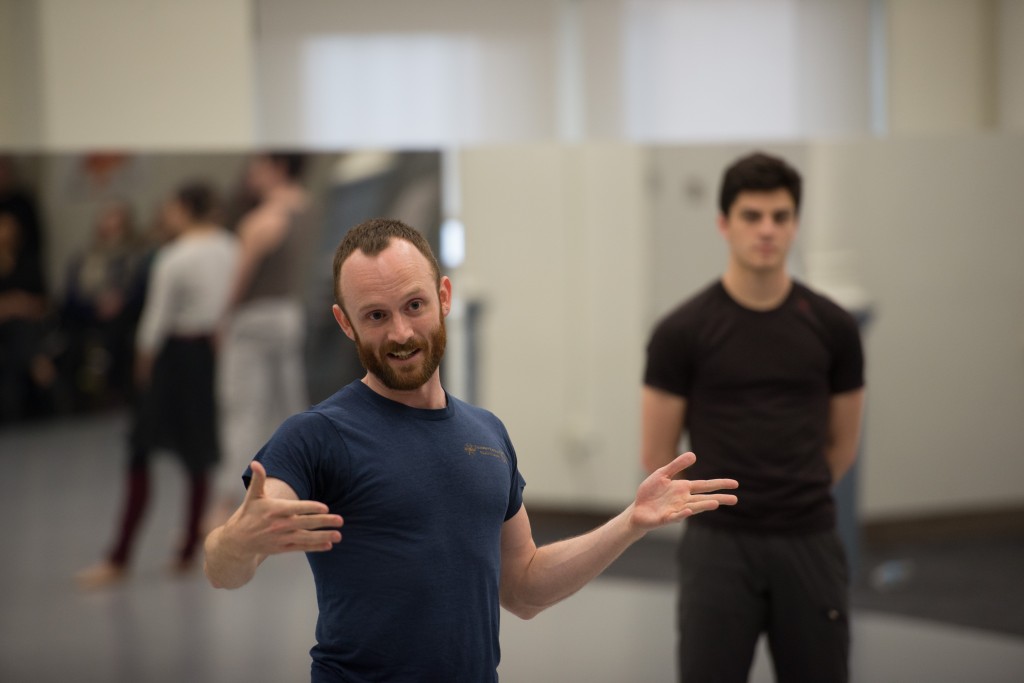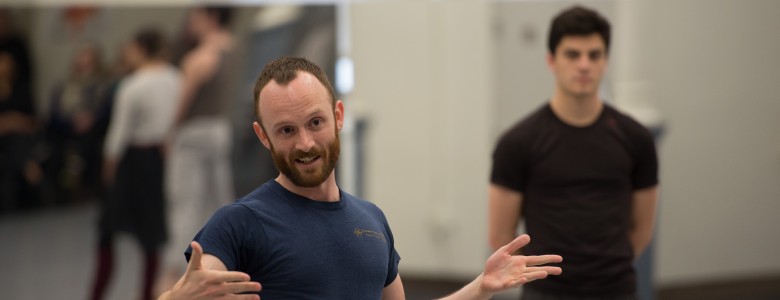The Pennsylvania Ballet will be the first American ballet company to learn Trisha Brown’s O zlozony / O composite (performances June 9–12 tickets/info), a 2004 trio made for the Paris Opera Ballet. These essays, written by long time Trisha Brown Company dancer Neal Beasley, detail the experience of setting Brown’s work on the Pennsylvania Ballet dancers.
“In the beginner’s mind there are many possibilities, but in the expert’s mind there are few.”
Shunryu Suzuki, Zen Mind, Beginner’s Mind

I’ve never been a fan of beginnings.
Before the first step of anything, the range of possible experiences is alternately exhilarating or terrifying, depending on my state of mind. A mentor once told me that at the outset of any venture, the difference between a sense of dread and adventure is just a question of perspective; the feeling is roughly the same.
I was with Trisha Brown in 2004 when she was making O zlozony / O composite for the “étoiles” of the Paris Opera Ballet—her first commission for a ballet company—so, to be fair, this isn’t exactly my first time at the rodeo. In fact, the restaging of this dance has been my domain many times, whether rehearsing the original cast for subsequent revivals, or teaching new generations of Parisian dancers the particular logic of its movement sequences. Each time, however, I have to stare down my own resistance. As a modern dancer in the universe of classical ballet, I often feel like a foreign peasant in a royal court.
In the days leading up to the start of rehearsals here in Philadelphia, I played a series of imaginary encounters in my mind. Like any good fantasy, these images were born of lived experience: the many hours in the sunlit studios of the Palais Garnier, piano accompaniment echoing through dusty old hallways. I imagined the bustling of ballet dancers, the sound of the vinyl booties they wear to keep their feet warm scraping against the floor as they scurry from one rehearsal to the next. I imagined the vague sense of watchfulness, the glances shot up while sewing a pair of pointe shoes—an attempt to assess who this new body is who walks around barefoot. Is friend or foe? Is he worth taking the time to acknowledge? Entering the ballet world is like entering another Anglophone nation: we speak the same language, but it sounds completely different. Our customs vary just enough to warrant wariness.
But above all I imagined the dancers that I would be working with. Dancing is such an intimate affair, and this dance in particular: a trio for two men and one woman. So much depends upon the nature of the communication between the bodies in the room; the ability to articulate what is and isn’t happening at a given moment; a receptiveness to correction, to new ideas and new information, and to the inherent power dynamics at play—for all parties involved; and an agreement to work together to understand and build something, the final form of which depends entirely upon everyone in the room.
While some rehearsal processes can be construed as an exercise in obedience, with the dancers’ successful adherence to the director’s will as the primary aim, Trisha’s work has always demanded a true sense of agency in the dancer: an awareness of one’s individual trajectory, its relationship to the other bodies in the space, the rhythmic structures of the phrase material, how those align or break from the surrounding rhythms, and how one is always making choices in moving from one moment to the next. This requires a degree of cooperation and responsibility that becomes impossible if dancers aren’t open to communicating, verbally and physically.
So the questions that swirled around my head were: Would they be open to thinking about their bodies differently? When I talk about the more fundamental physical values of Trisha’s work—the play of gravity on the limbs, mechanical efficiency, geometry of the joints, or cause and effect between seemingly unrelated parts—would they look at me like I have two heads? When I first encountered Trisha’s work, I was encouraged to let go of some things that I had once valued in my dancing (especially certain effortful notions of what was “impressive”) in order to discover new sensations. Can I convince them of the value of learning to move in ways that seem contrary to what they’ve spent their lives learning to do?
So much of the foundational premise of classical ballet is a resistance to gravity: the ethereal female, weightless enough to balance on the tips of her toes, or the valiant male soaring untethered in flight-like leaps. Here I am encouraging them to move from one gesture to another as if falling, surrendering to gravity instead of resisting. It’s hard at first to imagine that a fall can be beautiful. But when these ideas are approached with a willingness to experiment, to look less than graceful en route to a new understanding, they breed a level of nuance that is useful in any dancing.
Luckily, these ideas—and the tension between worlds that they articulate—form the aesthetic center of O zlozony / O composite. I often consider this work to be primarily concerned with translation, an examination of what is gained and lost in the dialogue between Trisha’s idiosyncratic approach to movement and the centuries-old lexicon of classical ballet. An impossibility is at play, given that these dancers will never devote themselves singularly to Trisha’s work. The goal when making this dance was never to turn ballet dancers into something they are not. Its power and beauty lies at the overlap between varying notions of beauty and how choices get made in relationship to different physical value systems. The dance lives as an ever-evolving artifact of what can be understood through the melding of two different worlds. Each time it is taught to a new group of bodies, it evolves anew. So much of the power of Trisha’s work—and this dance is no exception—comes from the unique contributions of the dancers who worked in the room with her. So as I approach this restaging on a brand new group of bodies, it is my goal to make room for their idiosyncrasies, in much the same way that Trisha has always taken pleasure from a variety of solutions to a common physical problem.
At the close of week one, I am feeling particularly fortunate. The three dancers who will be performing O zlozony / O composite, as well as the three understudying the work, are not only genuinely open to the material, curious and enthusiastic, but they also possess a physical receptiveness that is making the process move quickly and smoothly. The hall connecting the studios at the Pennsylvania Ballet indeed echoes with piano accompaniment. The dancers here, too, keep their feet warm with vinyl booties. And there is still that familiar sense of watchfulness—if not of the barefoot foreigner, then definitely the monitoring of who is getting to do what dancing. Such is the nature of hierarchical ballet structures. But within the studio is an ease that I find refreshing, given the number of times I’ve had to battle egos when teaching this work. It’s nice to feel that these dancers are with me, and I am excited by what might be possible if we continue to move at this pace, if we all continue to communicate well and nurture our enthusiasm. This beginning feels ripe with possibility, and as we walk into week two I hope to cultivate what feels like real promise. Already, I have seen a few moments of recognition: that special smile reserved for when a dancer first feels a new physical sensation. It’s my job to remind them that this dance.—and all dancing, really—can be a place of similar discovery. It’s a journey, and we’re only at its beginning.
—Neal Beasley
Photo by Johanna Austin

